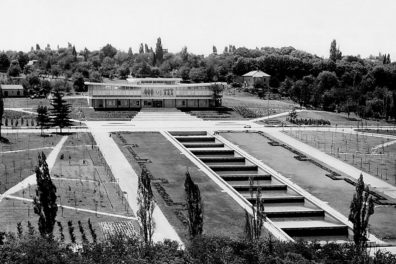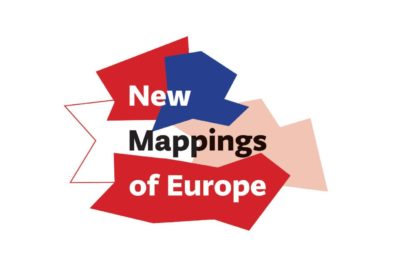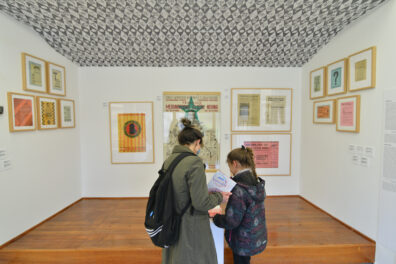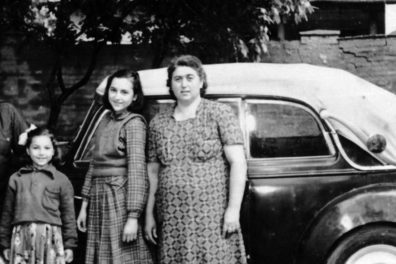PROGRAM OF DISCUSSIONS CLOSING THE PILGRIMAGE EXHIBITION
Part of the exhibition: THE PILGRIMAGE IN THE MUSEUM OF YUGOSLAVIA
In the Museum of Yugoslavia, on September 2, from 4 to 8 p.m., a series of discussions will be organised on the occasion of the closing of the Pilgrimage exhibition, authored by Ana Miljački. The focus of the exhibition, derived from the author’s personal response to the vandalism of the Partisan Cemetery in Mostar on June 15, 2022, are memories of collective school visits to NOB monuments in Yugoslavia. Artificial intelligence and “machine learning”, photo and video materials taken from private and historical archives were used to produce a kind of synthetic memory of those visits, offering a space for their new collective experience. At the same time, an important integral part of this six-channel video installation is the non-linear documentary soundscape authored by Pavle Dinulović, also created through artistic processing of various documentary materials.
Building on the basic theses of the exhibition, the discussions are organised around three thematically focused panels:
4.00 p.m.
CHILDHOOD
in Affective Histories of Yugoslavia
What might constitute an affective history, and why do we need such history of Yugoslavia? As historians, anthropologists, as well as architectural historians have described, when framing the story of Yugoslavia, while the Yugoslav time may be historical, the post Yugoslav space, architecture, artifacts, as well as many people who once inhabited that historical time, are still around, and in the present. How we navigate that particular way of straddling the past and the present is, as Tanja Petrović has suggested, both a political and an epistemological question. In this conversation we will consider various elements of a childhood in Yugoslavia relevant for affective, as well as for the broader socio-historical heritage.
Moderator: Ana Miljački (theorist and curator of architecture, Boston)
Participants: Sanja Petrović Todosijević (historian, Belgrade), Tanja Petrović (anthropologist, Ljubljana), Vladimir Perić Talent (visual artist, Belgrade)
5.30 p.m.
CONTEMPORARY MEDIA TECHNOLOGIES
in Broadcasting and Interpreting Cultural Heritage
Affective capacities of certain technologies of representation and communication are immediately obvious, while others get encoded over time and through habits of use. Relying on chemical processes, photographs were indexical, they had a specific relationship to facts, radio most powerfully orchestrated messages simultaneously across private and collective space, architecture speaks across vast historical time. In this panel we will discuss both the medium specific, structural aspects of contemporary technologies and their intended role and affect when transmitting research, as well as other types of stories involving cultural heritage.
Moderators: Simona Ognjanović and Marija Đorgović (art historians and curators, Belgrade)
Participants: Ana Miljački (architectural theorist, Boston), Pavle Dinulović (sound designer, Belgrade), Vladan Joler (visual artist and researcher, Novi Sad), Nika Grabar (architectural theorist and curator, Ljubljana), Martin Bricelj Baraga (artist and curator, Ljubljana)
7.00 p.m.
FUTURE
of Architectural Heritage of Yugoslavia
Architecture’s metaphorical role in building societies is fairly well understood. The inverse may be more traumatic and less well studied. Architectural heritage of Yugoslavia is anachronistic in contemporary post-Yugoslavian societies. Why is it important to preserve it, and what would it mean to preserve it for the future? How do we narrate the history of its value and how do we narrate its contemporary value? These are some of the topics we will discuss in this conversation.
Moderator: Jelica Jovanović (architect and researcher, Belgrade)
Participants: Marija Đorđević (museologist, Belgrade), Ana Kršinic Lozica (art historian and curator, Zagreb), Ana Bakić (architect, Zagreb), Ognjen Marković (student of architecture, Belgrade)
The Pilgrimage exhibition has been realised by the Museum of Yugoslavia and the Critical Broadcasting Lab at the Massachusetts Institute of Technology – MIT (Massachusetts Institute of Technology – USA). The team of authors of the exhibition, in addition to Ana Miljački, consists of Ous Abou Ras, Pavle Dinulović and Julian Geltman, while the curators of the exhibition are Simona Ognjanović and Marija Đorgović from the Museum of Yugoslavia. The preparation and research phase of the art project was supported by numerous researchers and associates, including Melika Konjičanin, Ana Martina Bakić, Jelica Jovanović – Group of Architects, Andrew Lowler, Sandro Đukić, CCN Images, Other Tomorrows. The first version of The Pilgrimage exhibition was shown in Venice in 2023, and the second at the Timişoara Architecture Biennale in 2024.
Martin Bricelj Baraga is a media artist and curator. He creates interactive works and sculptures that explore spaces between the environment, nature, technology and humans – his installations and interventions are often placed in unusual urban contexts or natural environments. His works in public spaces are included in permanent and temporary collections of the cities of Ljubljana. Geneva, Wroclaw, and St. Petersburg. He has received several international awards for his works, including awards from the GLOW festival, WRO Media Art Biennale, Europrix Multimedia Award, Memefest, and Baltimore Magazine, as well as a Plečnik Medal. He is the director of the MoTA – Museum of Transitory Art, the founder of the SONICA Festival in Ljubljana, and a member of the research-oriented art collective Nonument Group.
Ana Martina Bakić is an architect and associate professor at the Faculty of Architecture at the University of Zagreb, where she heads the Drawing design section. She is a PhD candidate at the University of Zagreb, studying architectural exhibitions, the intersection of artistic and architectural practices, as well as the way in which these practices embody specific experimental or archival concerns and formats. She collaborated on exhibition design of numerous exhibition installations with the WHW collective, including the Croatian presentation at the Venice Art Biennale in 2011, as well as the retrospective exhibition of Sanja Ivekovic at the Kunsthalle Wien and MSU Zagreb 2023, for which she was awarded the Croatian Museum Society Award for 2023. She is currently working on the retrospective exhibition of Vojin Bakic in Bjelovar, which will open in December 2025.
Sanja Petrović Todosijević is a Senior Research Associate at the Institute for Recent History of Serbia. Her research focuses on the social history of Serbia and Yugoslavia in the post-World War II period, with particular emphasis on the history of childhood, education, and the history of World War II. She is one of the founders of the Center for Yugoslav Studies. Dr. Petrović Todosijević has authored two monographic studies: Otećemo svetlost bučnom vodopadu. Reforma osnovnoškolskog sistema u Srbiji 1944-1959 (Belgrade: Institute for Recent History of Serbia, 2018) and Za bezimene. Delatnost UNICEF-a u Federativnoj Narodnoj Republici Jugoslaviji 1947-1954 (Belgrade: Institute for Recent History of Serbia, 2008). She was awarded the BeFem Bring The Noize 2023 recognition for her efforts in combating right-wing interventions in formal education.
Jelica Jovanović PhD student at University of Technology in Vienna, Institute for Art History, Archaeology and Restoration. Graduated from Faculty of Architecture University of Belgrade in 2010. Cofounder of Docomomo Serbia, former two terms secretary. Cofounder of the NGO Grupa arhitekata,. Attended courses of the Getty Conservation Institute (GCI), Cultural Heritage without Borders (CHwB), Central Institute of Conservation of Serbia, Center for Earth Architecture. External collaborator of several institutes of heritage protection in Serbia. Coordinator of the project Unfinished Modernisations: Between Utopia and Pragmatism, 2010-2012, (EACEA, Culture 2007-2013), and (In)appropiate Monuments. Curatorial assistant of the Museum of Modern Art in New York (MoMA) for the exhibition Toward a Concrete Utopia: Architecture in Yugoslavia 1948–1980. Coauthor of the platform Arhiva modernizma.
Tanja Petrović is a linguist and an anthropologist. She studied language and literature at the University of Belgrade and obtained a PhD from the Ljubljana Postgraduate School in Humanities (ISH) in 2005. Her dissertation was about language and identity strategies of a small Serbian-speaking community in Southern Slovenia and the relationship between the choice of language resources and broader social and political frames that were relevant for this community’s positioning. Dr Petrović is interested in uses and meanings of socialist and Yugoslav legacies in post-Yugoslav societies, as well as in cultural, linguistic, political, and social procesess that shape reality of these societies. Dr Petrović is a head of the Institute of Culture and Memory Studies ZRC SAZU and a professor at the ZRC SAZU Postgraduate school.
Nika Grabar graduated from the Faculty of Architecture in Ljubljana (2003), was a Fulbright visiting scholar at Columbia University, GSAPP, New York (2007-09), defended her PhD thesis at the Ljubljana Faculty of Architecture (2009). Her work involves research of architectural heritage with an emphasis on the heritage of modernism, contextualized in the international condition. With her research she investigates the possibilities of new critical approaches and methodologies in the field of architectural history and theory as key elements for understanding contemporary architectural issues. She is a member of the research-oriented art collective Nonument Group.
Marija Đorđević PhD (born Jauković, 1986) lives and works in Belgrade (Serbia). She is a senior research associate at the University of Belgrade – Faculty of Philosophy. Her main research interests belong to the domain of making, keeping and contemporary use of tangible and intangible cultural heritage, with a focus on participatory practices and inclusive development of narratives. She is further developing the concept of performing heritage as a method for recognizing and working with emancipatory practices as cultural heritage. She published the book Yugoslavia commemorates – site, body, and action for spaces of performing heritage in 2021. She is author of the book “Jugoslavija pamti: mesto, telo i poker za prostore izvođenog nasleđa” (https://reff.f.bg.ac.rs/bitstream/id/9952/bitstream_9952.pdf).
Pavle Dinulović, DA, is a sound designer and music composer from Belgrade, Serbia, specializing in the fields of interactive and performance art. Associate Professor at the Faculty of Dramatic Arts, at the Department of Sound Recording and Design, and a member of the faculty’s Interactive Arts Laboratory, he has exhibited or performed at venues such as the Ars Electronica Festival (2019, 2024), the Venice Biennale of Architecture (2023, 2025), the Prague Quadrennial (2015, 2023), Connected Ink in Tokyo (2021), Museum of Contemporary Art in Belgrade (2024), and Museum of Yugoslavia (2025).
Vladan Joler is a professor at the University of Novi Sad, researcher and artist whose work blends critical design, data investigations, counter-cartography, investigative journalism, writing, data visualization,and numerous other disciplines. He explores and visualizes different technical and social aspects of algorithmic transparency, digital labour exploitation, invisible infrastructures and many other contemporary phenomena in the intersection between technology and society. In cooperation with Kate Crawford, he published Anatomy of an AI System, a large-scale map and long-form essay investigating the human labor, data and planetary resources required to build and operate an Amazon Echo device. Craford and Joler also created the artwork Calculating Empires: A Genealogy of Technology and Power Since 1500 that won the Silver Lion Award at the 2025 Venice Architecture Biennale. He has curated and organized numerous events and gatherings of Internet activists, artists and investigators, including SHARE events in Belgrade and Beirut. His work is included in the permanent collections of the Museum of Modern Art (MoMA) in New York City, the Victoria and Albert Museum and the Design Museum in London, and also in the permanent exhibition of the Ars Electronica Center.
Vladimir Perić is a multimedia artist, present on the contemporary art scene for four decades. He studied graphics and photography at the Faculty of Applied Arts of the University of Arts in Belgrade. From 1986 to 1996 he presented his works under the pseudonym of Talent, then founded and exhibited within the Talent Factory Group until 2006, when he devoted himself to the Museum of Childhood project and other works that he exhibits under his own name. He has presented his works at over 80 solo and 200 group exhibitions in Serbia and abroad. Perić’s original typography, font FeO2 (2001) was included in the review of the most significant achievements of graphic design of the 20th century within the publication “Icons of Graphic Design” by Steven Heller and Mirko Ilić. He is the winner of Politika prize for fine art from the Vladislav Ribnikar fund for the exhibition “Made in Yugoslavia” (2006). He was the representative of the Republic of Serbia at the 55th Biennale of Fine Arts in Venice (2013). For the work “Bird Quarantine” (2020) he received the Nadežda Petrović Gallery award as part of the 30thMemorial in Čačak.
Ana Miljački is a curator, theorist, historian, and professor of architecture at the Massachusetts Institute of Technology (MIT) in the USA. Miljački is the head of the Critical Broadcasting Lab at MIT, which produces critical exhibitions about architecture in various media. She is the author and editor of numerous articles and books, including The Optimum Imperative: Czech Architecture for the Socialist Lifestyle (Routledge 2018). She has recently edited a special issue of the journal LOG: Coauthoring (2022), as well as JAE: Pedagogies for a Broken World. She was among the three-member curatorial team of the American Pavilion at the 14th Venice Architecture Biennale in 2014 with the project: OfficeUS. The most recent series of her scholarly and polemical works deals with collective authorship and copyright, the status of copies, as well as the affective history of Yugoslav architecture.
https://criticalbroadcast.net/
Ognjen Marković is second-year undergraduate student at the University of Belgrade – Faculty of Architecture. Engaged as a teaching assistant in Descriptive Geometry. Focused on research into the modernist architectural heritage of former Yugoslavia. Actively participates in the student initiative “Ansambl Generalštab”, dedicated to raising public awareness about the importance of protecting and preserving cultural heritage in Serbia. Member of the National Committee of ICOMOS Serbia.
- Day: 02.09-02.08.2025
- Time: 16:00

The Origins: The Background for Understanding the Museum of Yugoslavia
Creation of a European type of museum was affected by a number of practices and concepts of collecting, storing and usage of items.

New Mappings of Europe

Museum Laboratory
Starting from the Museum collection as the main source for researching social phenomena and historical moments important for understanding the experience of life in Yugoslavia, the exhibition examines the Yugoslav heritage and the institution of the Museum

